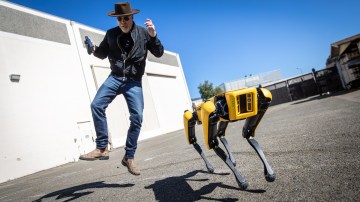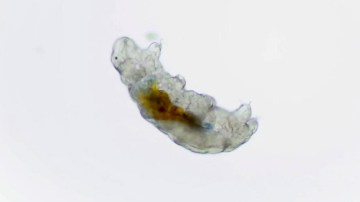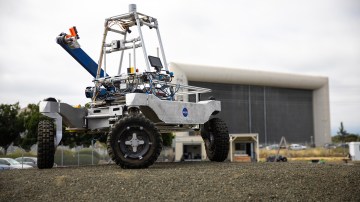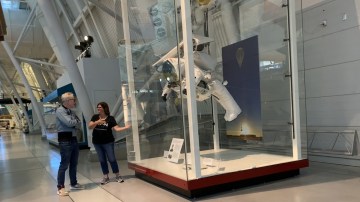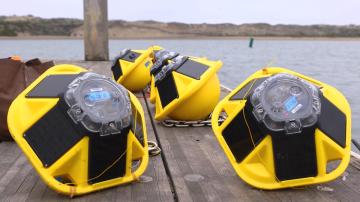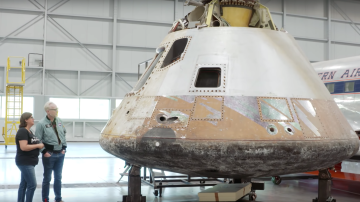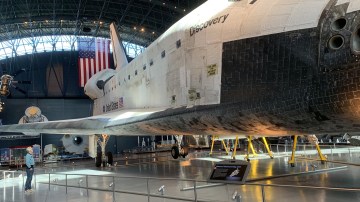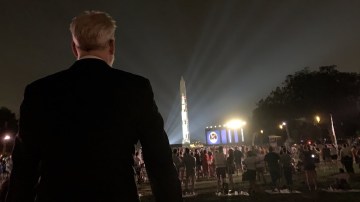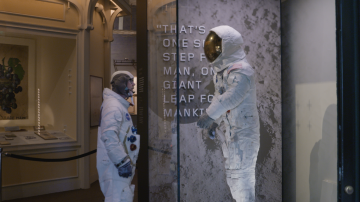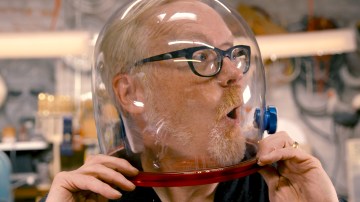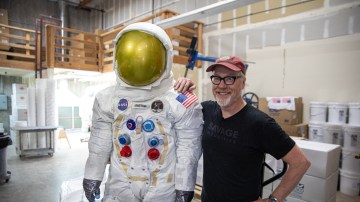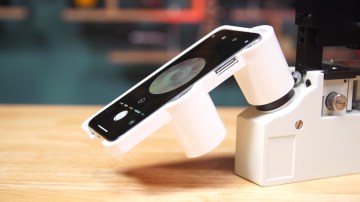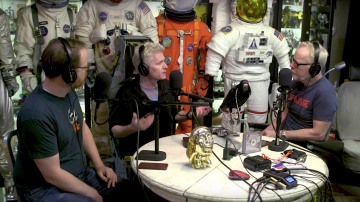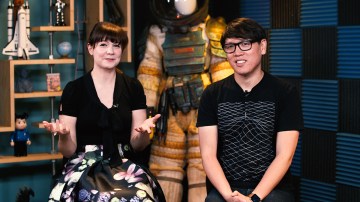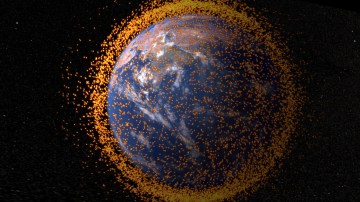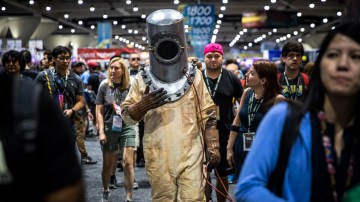TRANSCRIPT: Adam Savage Interviews NASA’s Dava Newman
Miss the video? Read Adam's interview with Dava Newman of NASA, and learn (among other things) when she predicts a regular person will be able to spend a week in space.
Adam Savage: Hey! Welcome to The Talking Room. We have borrowed all the elements from The Talking Room, including my dining room chairs. Even Winston the Beaver, the patron saint of the Talking Room, is here. He’s holding on to the card that says who our next guest is. She’s a hero of mine. She’s an astronaut assistant, aeronautic assistant, an MIT professor, a doctor, and recently a deputy director of NASA. Please welcome to the stage Dana Newman.
Dava Newman: Thank you. Thank you.
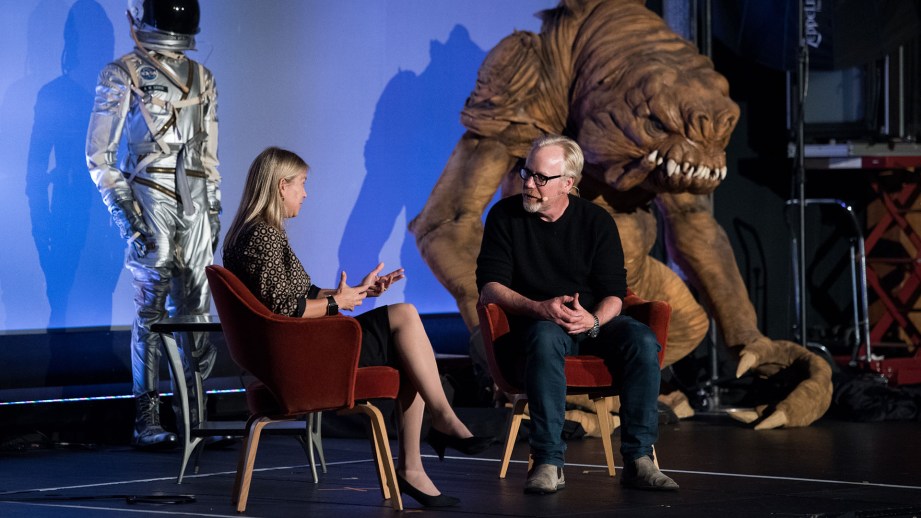
Adam Savage: You know, I have to tell you, in preparation for your arrival we had to have lots of discussions about how many of my spacesuits we should actually transport over here. You are also a spacesuit designer, of the future of spacesuits.
Dava Newman: Going to Mars. We’re going to Mars.
Adam Savage: We’re going to Mars.
Dava Newman: But back to the beaver mascot, what a great mascot. That’s the world’s engineer. You’ve got a beaver up here!
Adam Savage: Exactly. Now, what I really want to talk about first off is The Martian.
Dava Newman: OK.
Adam Savage: The Martian‘s gotten me all excited not only about the next spacesuit I’m probably going to build, but how realistic is The Martian overall?
Dava Newman: It is fantastic. How many people have seen it? I hope everybody. First, back to the book. Andy [Weir] did a great job. He did so much research. He got the technology right. He took a little artistic license, but he told you when he did, and then Ridley Scott with the movie was spot on. It’s the best movie in terms of space yet, in terms I think of the factual reality, besides the documentary.
Adam Savage: I don’t know if you know this but we had a Tested event last weekend, and Andy Weir and Chris Hadfield were there. Someone asked the three of us if we would go to Mars, and Andy said, “No way in hell.”
Dava Newman: He doesn’t like to fly.
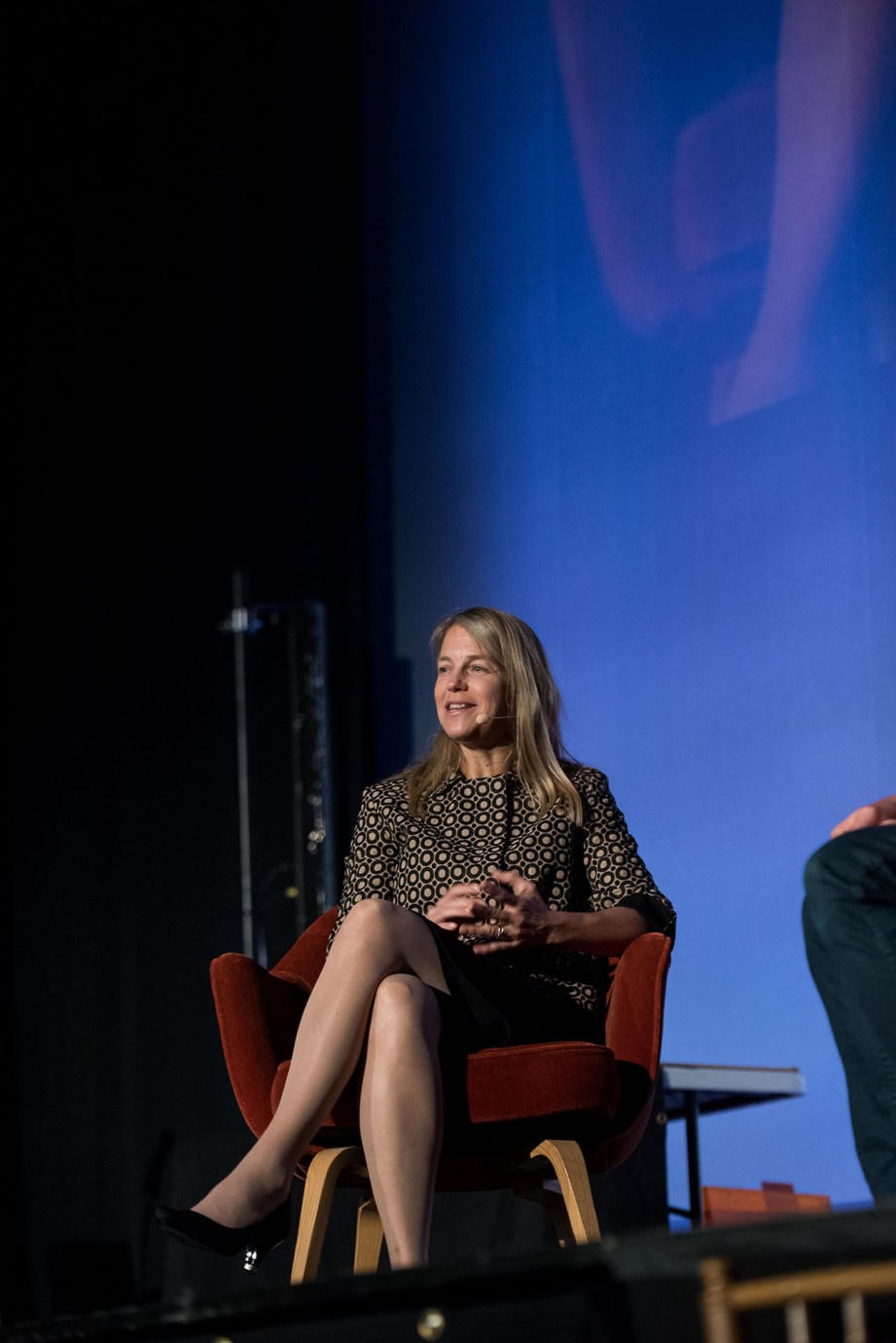
Adam Savage: NASA got him over his fear of flying when they offered him trips to their various facilities, and he figured, “I can work up to that and get it going.” I’m really curious … I think the main thing I thought when I read the book The Martian, and then saw the movie, is that the biggest leap in technology that’s implied is in the spacesuit itself. Unlike the bulky EVA suits that we grew up seeing in the Apollo missions and now in the ISS, the Martian suits are very, very sleek and they reminded me of a lot of your spacesuit design. How realistic is that?
Dava Newman: I think it’s really realistic — tight, formfitting. I mean, we started a little bit more formfitting way back, and then we’ve gotten bigger … and with weightlessness up on International Space Station, you’re floating so you can add mass and still do your work. But we’re going to Mars and so we need a planetary suit. It has to be low mass, very mobile, very flexible.
Adam Savage: What are the different engineering challenges between moving from the large suit … I mean it’s got positive pressure inside.
Dava Newman: Yes.
Adam Savage: I’m assuming the formfitting suits will also have positive pressure inside, but is it less volume …
Dava Newman: Yes, maybe a hybrid. So less volume. So there’s two ways to pressurize someone in the vacuum of space. You can put them in a balloon. Then you have to work against the balloon, so they’re not very mobile. But if we make the balloon really small … And what if we could pressurize right on the skin? That’s called mechanical counter pressure. We have to look at these concepts because again you want to give someone their natural mobility, because they have a lot of work to do.
Adam Savage: Yes.
Dava Newman: We’re going to Mars to explore, search for life. So the Martian extreme environment … You saw Bobak Ferdowsi’s pictures of Mars — you might have noticed that Valles Marineris is cool. It’s like the Grand Canyon, but the Valles Marineris would stretch across the entire United States.
Adam Savage: Wow.
Dava Newman: So that’s a valley. And Olympus Mons makes Everest puny. Olympus Mons is something, so we have to be ready for that incredible martian terrain.
Adam Savage: Now you were recently named Deputy Director of NASA twice. Am I right?
Dava Newman: I was nominated twice. I got confirmed once.
Adam Savage: Oh, OK. That’s a very different mission than designing spacesuits and teaching at MIT. How has that changed your life?
Dava Newman: Well, obviously I think I had the world’s best job teaching students, doing research, and thinking about how get humans to Mars. First I was training students that all want to be astronauts and do the mission and then I was given the opportunity to join the government. I always wanted to serve and it’s great timing. I think we have great momentum. So I’m just humbled and honored. I joined Charlie Bolden, the administrator, and we have a great team. We’re pretty focused on our journey to Mars. It’s been great, I have to tell you. This is something else; it’s been a great job.
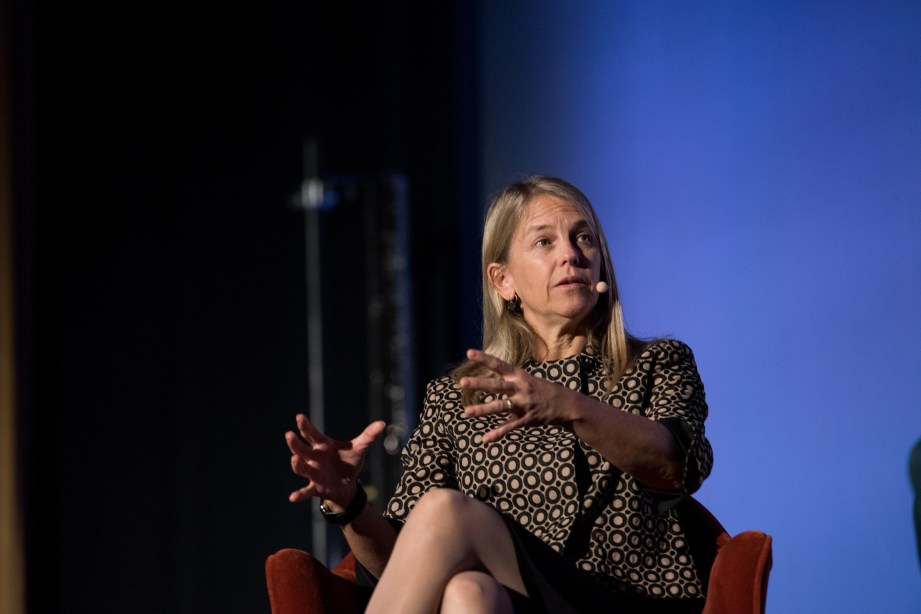
Adam Savage: You have traveled to the NASA facilities. Am I right?
Dava Newman: I did. In July and August I went and saw them all … I’d worked at about half of them before. I thought I knew NASA, but now I’ve traveled to all of them. Every single one. I learned so much and the people are so motivated, and they’re doing great things. We’re building our space launch system, we’re building Orion. First we’re at the International Space Station. Shout out to Scott Kelly — he’s up there, just 400 kilometers up. Every 90 minutes he’s going over. So we are doing our one-year mission and we’re learning a lot about astronaut performance and human health. We move beyond low Earth orbit and we get to assist lunar, Earth moon orbit, and we call that the proving ground. We’re proving technologies. We have to learn how to do these things, but it’s hard; we’re farther away from Earth. With the space station we are Earth dependent.
Adam Savage: Right.
Dava Newman: I’m a sailor so we get to assist lunar. Now you’re days to a week away, so that’s like crossing an ocean, because maybe help can come, but it’s going to be days or weeks. Mars is really far away, so you have to be completely Earth independent when we get to Mars. So we’re thinking we’ll get there in the ’20s or ’30s.
Adam Savage: I know moon dust caused lots of problems for the astronauts’ suits for the operation of the equipment, seals, cetera. Does martian dust present interesting problems that are similar? Did the moisture on Mars actually wear it into some nice smooth sand?
Dava Newman: It will present problems for the lunar regolith, a fancy word for dirt. Moon dust or dirt. It’s really sharp, it has a lot of shards in it so it seems really fine granules, but they’re very spiky. It’s not good for a spacesuit. If you’re pressurized, you don’t want anything poking you.
Adam Savage: No.
Dava Newman: So there’s sharp regolith and when we get to Mars the dust we see … Really all the rovers have been performing incredibly well. Of course, there is the wind. Not like the big wind storm you saw on The Martian. I mean, we have 1% atmosphere, so wind and dust, but it might feel like a feather instead of that big 150-mph windstorm. So we worry about the dust because dust in bearings is not good.
Adam Savage: Right.
Dava Newman: It can foul the bearings. If you didn’t have bearings to start with you’d still be pretty mobile. It’s a good design challenge.
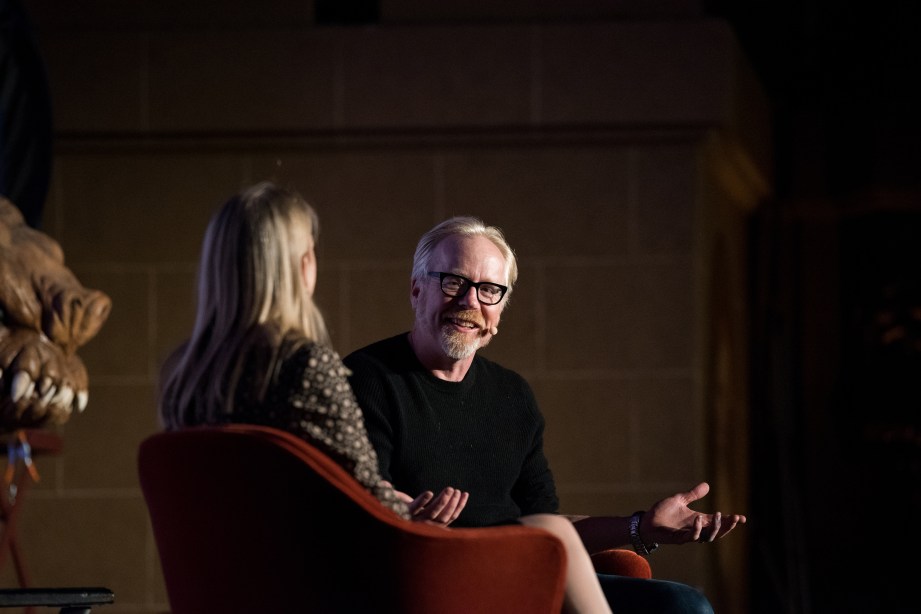
Adam Savage: Do you find as an engineer visiting the various NASA facilities, now as an administrator, that you want to roll up your sleeves and get your hands dirty and start to work with them?
Dava Newman: Yes. Yes. That’s why I like to go to the centers, because they have all the cool stuff.
Adam Savage: Yes.
Dava Newman: They have toys. Headquarters, I don’t have to many toys yet. I’m waiting for a science on-sphere and things like that, but I go out to the centers. I went to JPL [Jet Propulsion Laboratory] and they have Mars rovers. How cool is that? We have to do the problems, “Hey, the treads on the tires, they’re wearing out because of the regolith.” Well, we don’t know, it’s hard to know what the Mars dirt is made out of. Now we know because we’re driving over it and there is some funky wear on the tires. So they are studying it.
I went to Marshall Space Flight Center where the big engines are and we do the rocket propellant. So I asked a question because I have a little 3-D printer at MIT, but the one I could afford like a $1,000 one or so. My students run it 24/7. I went to Marshall and I said, “How do we do 3-D additive manufacturing with metals?” Because I know you can do it, but I hadn’t seen it. So there they are with aluminums … They show me a rocket engine out of copper. Had like 26 parts, a normal rocket engine has a 168 parts that are, takes a long time to do them, they all have to come together. Boom. 3-D printed rocket engine. Super cool.
Adam Savage: I also noticed … Actually this might be something astronauts watching the film also noticed is that they got in and out of those spacesuits in minutes.
Dava Newman: Pretty fast.
Adam Savage: The actuality is that it’s more like 90 minutes?
Dava Newman: Right now it takes a while, but right now you get into the suit and you have to wash it out. So you have to breathe oxygen so you dehydrogenate. If you’re a scuba diver people know about this. You don’t want to get decompression sickness or the bends, nitrogen bubbles in your bloodstream. So you breathe pure oxygen, that’s actually what takes a while. Getting in the suit itself is 10 minutes, but then you’re going to breathe your oxygen. You’re going to make sure that …
Adam Savage: As the suit pressurizes or …
Dava Newman: You’re pressurized.
Adam Savage: OK.
Dava Newman: But you’re going to sit in there for a while.
Adam Savage: I see.
Dava Newman: Given the oxygen content, so again a little bit more like scuba diving because you’re going to a low pressure environment. So in scuba diving we go down deep and we’re pressurized and that’s why you have to come up slow. You come up slow because you’re losing pressure and you don’t want any gas in your bloodstream to go into volume. So you just do that really slowly. Nitrogen is an inert gas in our bloodstream. So you want to get that out. So we go into a spacesuit it’s kind of like coming up from diving if you will.
Adam Savage: Right.
Dava Newman: You’re going into a lower pressure environment.
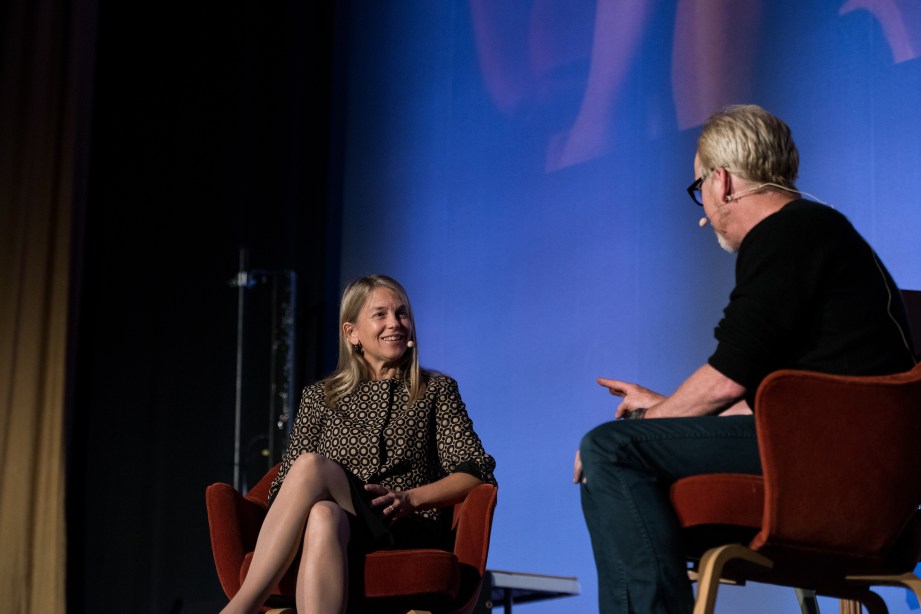
Adam Savage: I have to say, I read a lot about how beat up the rover’s tires are from the martian surface. It’s astonishing me. They’re titanium, right? Am I correct? They have big holes in them from the rocks they are driving over. I had no idea that the surface was that rough.
Dava Newman: Yeah, it seems to be. It’s a cold place. Mars is harsh, a harsh environment. That rover has been doing pretty well.
Adam Savage: It has been doing amazingly well. Are we looking at future rovers that we will be able to 3-D print their own replacement parts on the road?
Dava Newman: That’s the challenge. You have to make the maker, you don’t get to send the maker to Mars. We have to get to Mars and the maker has to make itself.
Adam Savage: I’ll go, if somebody wants to send me. I’m totally happy to go. Just to space. Just to help them out in space, not to Mars. The genesis of a NASA scientist … Did you always want to go to space when you were a little girl? Is this something you’d been thinking about a long time?
Dava Newman: I grew up in Montana so we had a great big sky country. My family is from Northern California actually, Berkley area. Right here in the Bay area. I guess we were always explorers, my family. My great-grandfather, I never got to meet him, but he came over in a boat from Finland. I guess by nature I had a genetic disposition for exploration, but it was Apollo for me. I was a young girl and saw Apollo, that just taught me to dream. If we can go to the moon we can do anything. I didn’t always know I was going to be an aerospace engineer. I definitely didn’t know I was going to be deputy administrator of NASA, but you just dream and I love being an aerospace engineer. I kind of specialize in astronaut performance, so it’s really fun because I want to see how we can keep our astronauts healthy and well and alive.
Adam Savage: What is important? Why do we need to go to space? What is the import for NASA of pushing ourselves out into the solar system?
Dava Newman: I can answer it for me. We all have to answer it for ourselves, but it’s we’re explorers. We are always going to the horizon — that’s what humans have done and humankind. There are some practical reasons: leadership, national pride, education, science. So we can go through lists, but the enduring question is to go where no one’s ever gone. To go together. I think we will go to Mars. Our journey to Mars and astro-partners we would love the world to go with us. We’re going to lead, that’s what NASA does well, that’s what the U.S. does well. We would like to have a lot of international partners, but those are the enduring questions. We’re explorers at heart. Going to the unknown. Our probes and space science go way beyond Mars. It’s great to be at Mars, but right new horizons. I mean, Pluto? Now we have been to all the planets.
Adam Savage: Amazing.
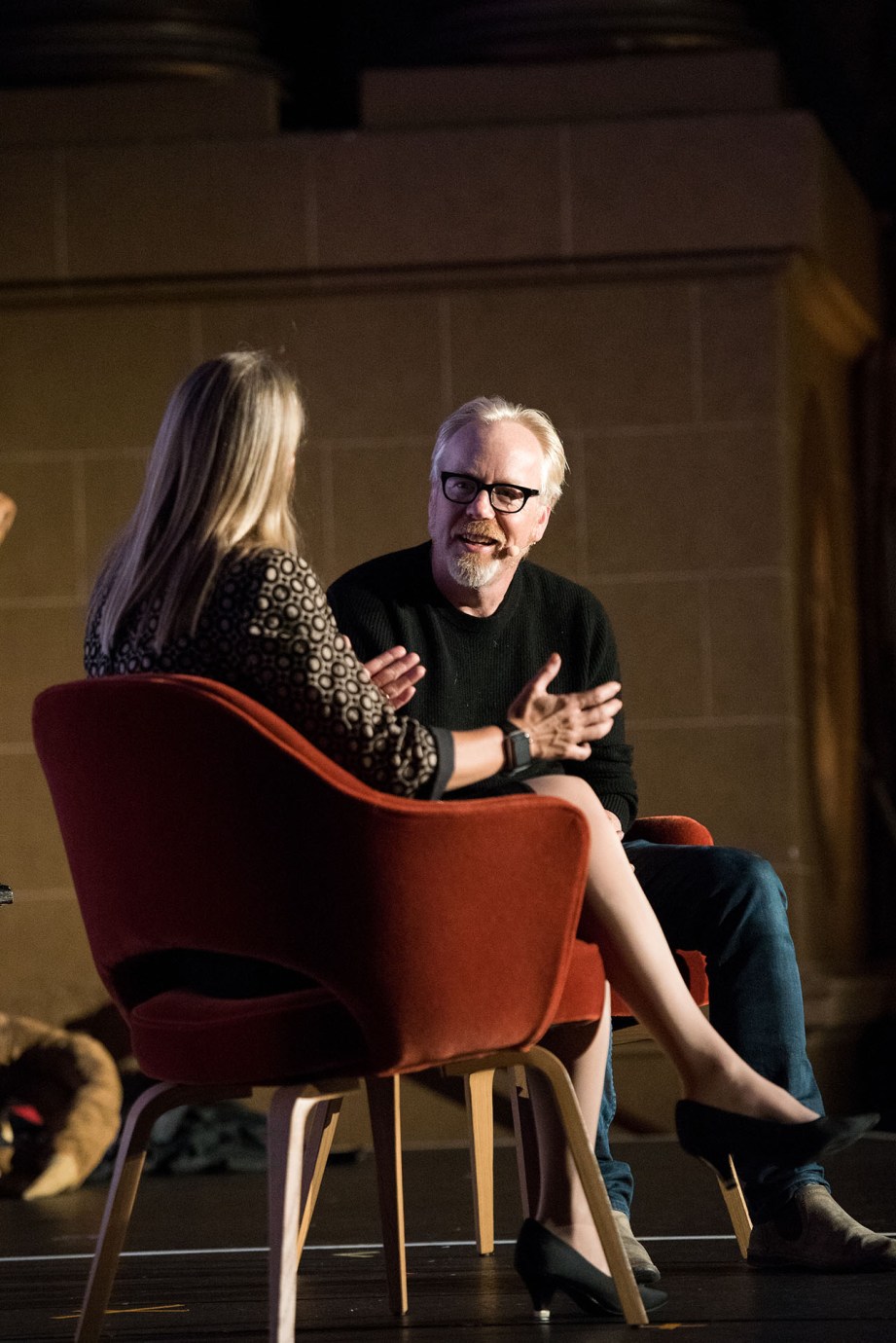
Dava Newman: I count dwarf planets. So we are exploring and then we had exoplanet week. So we have been celebrating all week. I had to study up. I learned a lot. I mean, that is hard to get your head around that we have a thousand exoplanets — 4,000 that are possible, 25 they call in the “sweet zone,” habitable planets. Other galaxies. This is wild.
Adam Savage: Is there something you’ve learned in your new job as administrator that you didn’t realize about NASA as an organization? How many people work at NASA?
Dava Newman: Well, we have less than 17,500 civil servants, government employees.
Adam Savage: Right.
Dava Newman: But contractors are of course our partners, collaborators, that work right with us at the centers too. That is probably another 40,000. Add it up, a rough number os 60,000 folks. Then university folks where I came from. So the grants, and all the students, and professors involved. Then it’s hundreds of thousands of people, I guess, but it’s really about 18,000 civil servants, and then the 14,000 at our centers that are just the contractors.
Adam Savage: You and I were at the White House Astronomy Night on Monday night and Bill Nye said something I really, really liked. He said, “The United States hasn’t enjoyed the best reputation around the world, and it’s been getting better lately, but NASA is the best brand we have. It is our greatest outreach. No one doesn’t love NASA around the world.”
Dava Newman: That’s right. I know. Yay.
Adam Savage: What about a little boy or little girl that is interested in being a NASA scientist or an astronaut. What should they study? What should they look towards?
Dava Newman: They should just go with their heart. I actually am a huge proponent of S.T.E.A.M., but I have changed it to STEAM.
Adam Savage: Yes!
Dava Newman: I put in the arts because I’m inspired by art. It’s about the artist visioning our future. That’s what they did. I want all you artists out there — please help me with the vision to Mars. Now you actually have some HD, great images to use because we know what it looks like, but you’re so important. You’re the storytellers for all of us nerds that are the technologists and the engineers. I made it, I always called it STEAM myself, recently because I need the maker generation. I need the ones who want to get down and dirty and 3-D print. If you’re a designer then NASA is for you, then our journey to Mars is for you because all I know is I need everybody.
Adam Savage: Thank you. Yes, absolutely. Has NASA been gaining insight or technologies from the maker community?
Dava Newman: Yes, we have some great examples. NASA Ames [Research Center] and all the centers right here. And the new start-up Made in Space. Cool name. These guys are doing 3-D printing, gave us our first 3-D printer up on International Space Station.
Adam Savage: And they just printed a wrench that works.
Dava Newman: Yes. I have a copy of it, it’s fantastic. It’s ABS, it’s plastic, but you know in space and weightlessness, you don’t need a lot of torque. So that’s handy. You get up there and it’s like, hmm, because you spin Newton’s third law. Spin and you’re going to move the other way. Now, when we start building things and get to the planets we’re going to need a little bit more, but again now that we can probably do metals and alloys, basalt. There’s a lot of basalt. That’s going to be the material for the 3-D printers of the planets.
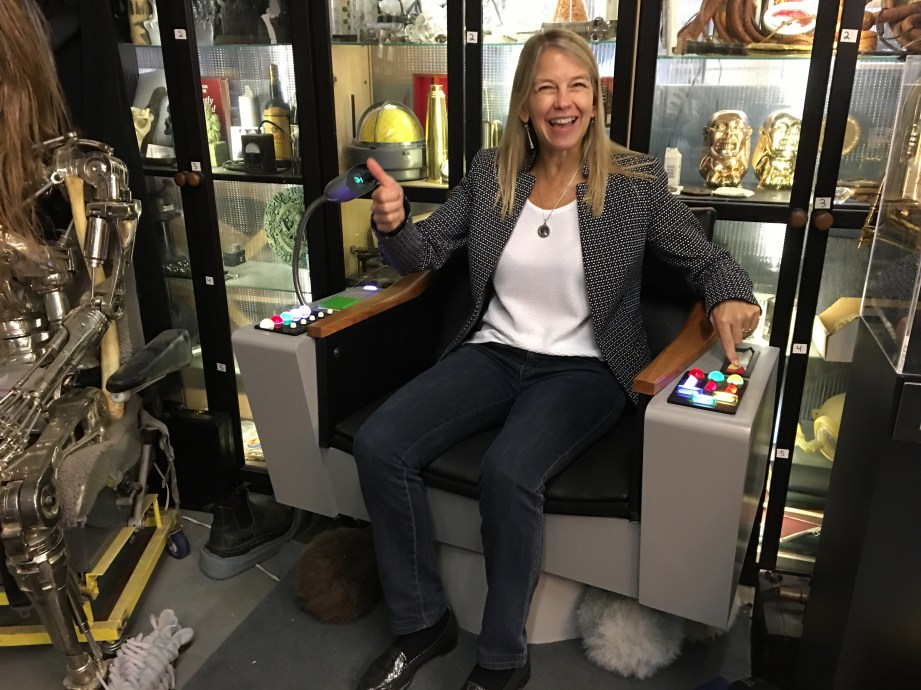
Adam Savage: Now at the Astronomy Night there was NASA’s commercial crew who was working with both Space X and Boeing for the next generation of vehicles to take us up to the International Space Station. That’s brand new for NASA.
Dava Newman: Yeah. It’s a new partnership. It’s public, government funded, public, private. So we are looking to industry. They are on board. It’s exciting, NASA is a great brand and everyone wants to play … We need everyone and so we are actually going to try to be the new NASA, in terms of what kind of partnerships can we have? If private industry is coming to us and they want to play, and we’re depending on them. Right now we are depending on these folks for our commercial crew launches because that lets NASA get beyond low Earth orbit and get into exploration. We’ve got to get back to lunar, we’ve got to go beyond lower Earth orbit. We’ll still be in lower Earth orbit as humanity. There’s lots to do. It might be some big commercial gains there. The pharmaceutical industry, the material science industry. So again that’s more for the private sector to do. And then we’ll move out and keep moving out into the solar system and explore.
Adam Savage: This is another question that a lot of people ask because what are the practical results back here on Earth for us of the stuff that NASA researches and discovers?
Dava Newman: I have a huge list. Knowledge, information, inspiration. Practical things. NASA really didn’t … The Tang thing. I don’t think that was really NASA invention.
Adam Savage: No.
Dava Newman: But solar shades, Gore-Tex and things like that really did come from the space industry. Again, it is just the investment and research, and technology, and materials. The inspiration — the young girl like me who can see Apollo and end up being an aerospace engineer. So it’s the whole story, it’s the inspiration. It’s just getting things done, it’s striving to be excellent. To do the best that science and technology that we can.
Adam Savage: NASA encompasses so many different fields. We have worked with NASA several times on MythBusters, many times over the last 13 years, and one of the things that I find amazing is if you deal with scientists you’re often dealing with specialists who focus on a very specific thing. At NASA I find that even their specialists are generalists. They have hobbies that have nothing to do with the field that they’re an expert in and every NASA scientist I’ve ever met has that. From every astronaut and you as well. That seems to pervade the whole culture of NASA, that kind of generalist idea.
Dava Newman: I call them Pi people because you can be deep in maybe aerospace and maybe … T people, the T model came first. Go deep in one, but you have to be broad. You want to be an educated person. I’m an engineer, but I sure better know about economics, and statistics, and history, and things like that. Being an engineer I like Pi better, you know 3.14. Maybe we can go deep in a couple areas, but then the broadening, the holistic view you have to be able to communicate with your neighbor. We have to tell our stories as scientists and engineers or else no one will listen.
Adam Savage: So how soon will we be allowed to take a quick trip to space for a week? How soon? A couple years, 5 years, 10 years?
Dava Newman: Way within 10 years for sure. A couple years?
Adam Savage: Way within 10 years? Can I go? Will you guys send me up there?
Dava Newman: How much money do you make?
Adam Savage: I don’t have that much.
Dava Newman: I can’t afford you …
Adam Savage: But I’m a communicator.
Dava Newman: You’re a communicator. Good.
Adam Savage: Dava, thank you so much for joining us …
Dava Newman: Thank you, Adam. What a pleasure.
Photography courtesy of Dallis Willard

One Day Builds
Adam Savage’s One Day Builds: Life-Size Velocirapt…
Adam embarks on one of his most ambitious builds yet: fulfil…

Show And Tell
Adam Savage’s King George Costume!
Adam recently completed a build of the royal St. Edwards cro…
All Eyes On Perserverance – This is Only a Test 58…
We get excited for the Perserverance rover Mars landing happening later today in this week's episode. Jeremy finally watches In and Of Itself, we get hyped for The Last of Us casting, and try to deciper the new Chevy Bolt announcements. Plus, Kishore gets a Pelaton and we wrack our brains around reverse engineering the source code to GTA …
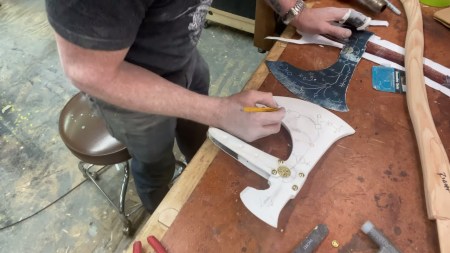
Making
Adam Savage in Real Time: God of War Leviathan Axe…
Viewers often ask to see Adam working in real-time, so this …

One Day Builds
Mandalorian Blaster Prop Replica Kit Assembly!
Adam and Norm assemble a beautifully machined replica prop k…
House of MCU – This is Only a Test 586 – 2/11/21
The gang gets together to recap their favorite bits from this past weekend's Superb Owl, including the new camera tech used for the broadcast and the best chicken wing recipes. Kishore shares tips for streamlining your streaming services, and Will guests this week to dive into the mind-bending implications of the latest WandaVision episod…

One Day Builds
Adam Savage’s One Day Builds: Royal Crown of Engla…
One of the ways Adam has been getting through lockdown has b…

Making
Adam Savage Tests the AIR Active Filtration Helmet…
Adam unboxes and performs a quick test of this novel new hel…

Making
Weta Workshop’s 3D-Printed Giant Eyeballs!
When Adam visited Weta Workshop early last year, he stopped …

One Day Builds
Adam Savage’s One Day Builds: Wire Storage Solutio…
Adam tackles a shop shelf build that he's been putting off f…






